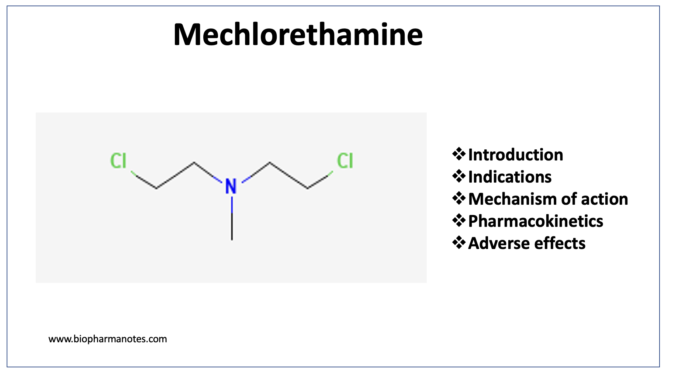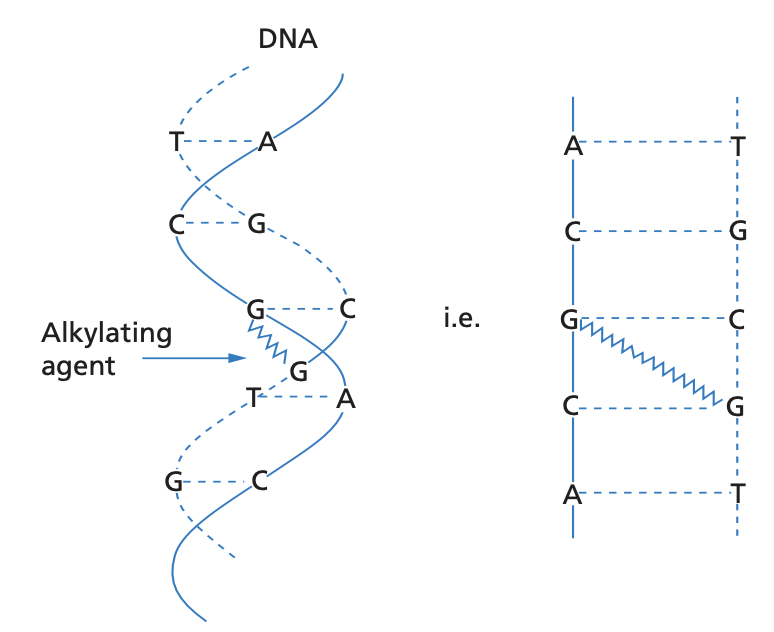
- Mechlorethamine is first nitrogen mustard used in cancer therapy. It is also known as mustine or chlormethine. It was used as war gas before and has been used in clinical field since 60 years.
- Nitrogen mustard falls under alkylating agents used in chemotherapy. Mechlorethamine is the most reactive agents among nitrogen mustards. When used locally, it acts as vesicant (drugs or agents that cause tissue necrosis or blister formation when infused into tissue surrounding a vein).
- It has been replaced by other stable alkylating agents like cyclophosphamide, melphalan etc. Cyclophosphamide, chlorambucil and melphalan are synthesized by modifying chemical structure of mechlorethamine and are safer and better tolerated than it.
- It was approved for medical use in United States in 1949. The gel form of mechlorethamine was approved on August 23, 2013, for treatment of stage IA and IB mycosis fungoides-type cutaneous T-cell lymphoma.
Indications of Mechlorethamine
- Used in combination cytotoxic regime to treat different kind of cancer including refractory Hodgkin’s disease,
- It is used topically in treatment of cutaneous T cell lymphoma.
Mechanism of action of Mechlorethamine
- It works by multiple mechanisms. It forms highly reactive ethyleneimine ions which alkylate and cross-link guanine bases in DNA which prevent strand separation during transcription or DNA synthesis, attach alkyl group to DNA bases which prevent DNA synthesis and RNA transcription from affected DNA, induce mispairing of nucleotides leading to mutation and alkylate other macromolecules like protein. These all results in disruption of DNA function and results in cell death.
- It is active in all phases of cell cycle.

Figure- Mechanism of intramolecular bridging of DNA by mechlorethamine (Source- A textbook of Clinical Pharmacology and Therapeutics, 5th edition)
Pharmacokinetics
- It can be used topically or via IV bolus administration. It is also administered via intrapleural, intraperitoneal or intrapericardial route.
Adverse Effects
- It is very toxic effects. Common side effects include nausea, vomiting, lacrimation, myelosuppression, leukopenia, and thrombocytopenia. Nausea and vomiting usually occurs within first 3 hours of administration. To prevent nausea and vomiting, it is suggested to be taken before bedtime with prophylactic antiemetic agent. It can also cause alopecia, amenorrhea, and azoospermia.
- When used as topical formulation, it can cause pruritus, dermatitis, hyperpigmentation, skin blistering and ulceration.
- It is not recommended to be used in pregnant woman and breastfeeding mothers.
References
- https://go.drugbank.com/drugs/DB00888
- https://www.ncbi.nlm.nih.gov/books/NBK548509/
- Cancer Immunotherapy. Immune Suppression and Tumor growth. 2007; Pages 101-116.
- Pharmacology and Pharmacotherapeutics. 24th edition.
- Goodman and Gillman Manual of Pharmacology and Therapeutics.
- Lippincott Illustrated Reviews Pharmacology, 6th edition.
- A textbook of Clinical Pharmacology and Therapeutics, 5th edition.